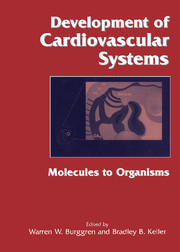Book contents
- Frontmatter
- Contents
- List of contributors
- Foreword by Constance Weinstein
- Introduction: Why study cardiovascular development?
- Part I Molecular, cellular, and integrative mechanisms determining cardiovascular development
- Part II Species diversity in cardiovascular development
- Part III Environment and disease in cardiovascular development
- 17 Oxygen, temperature, and pH influences on the development of nonmammalian embryos and larvae
- 18 Modeling gas exchange in embryos, larvae, and fetuses
- 19 Principles of abnormal cardiac development
- 20 In utero and postnatal interventions for congenital cardiovascular malformations
- 21 Applying the science of cardiovascular development to congenital cardiovascular malformations
- Epilogue: Future directions in developmental cardiovascular sciences
- References
- Systematic index
- Subject index
19 - Principles of abnormal cardiac development
from Part III - Environment and disease in cardiovascular development
Published online by Cambridge University Press: 10 May 2010
- Frontmatter
- Contents
- List of contributors
- Foreword by Constance Weinstein
- Introduction: Why study cardiovascular development?
- Part I Molecular, cellular, and integrative mechanisms determining cardiovascular development
- Part II Species diversity in cardiovascular development
- Part III Environment and disease in cardiovascular development
- 17 Oxygen, temperature, and pH influences on the development of nonmammalian embryos and larvae
- 18 Modeling gas exchange in embryos, larvae, and fetuses
- 19 Principles of abnormal cardiac development
- 20 In utero and postnatal interventions for congenital cardiovascular malformations
- 21 Applying the science of cardiovascular development to congenital cardiovascular malformations
- Epilogue: Future directions in developmental cardiovascular sciences
- References
- Systematic index
- Subject index
Summary
Introduction
Standing on the shoulders of the many articles and reviews on cardiac development based upon descriptive approaches, and using tools developed with the aid of molecular biology (Pexieder, 1995), one can see new horizons. However, much to the chagrin of the increasing number of scientists equipped with molecular tools and interested in morphogenesis, the primary focus of research remains the refinement of descriptive events. Achieving significant new breakthroughs will necessarily require a move from the prevailing descriptive thinking to analysis identifying direct cause-effect relationships in order to expose the mechanisms underlying abnormal development.
The present chapter will focus on several crucial steps in normal cardiogenesis that have been identified as major developmental “bottlenecks.” The impact of such a bottleneck is that distinct morphogenetic disturbances may at first sight appear to produce similar heart malformations. Critical analysis, however, shows that unique pathogenetic mechanisms produce a spectrum of unique results. Understanding of this principle is essential for both the basic scientist and the clinician. The following examples will provide insight into the complexities, the pitfalls, and – if well considered – the opportunities for improving the resolution of our perception.
The paradox of the double-outlet right ventricle
“Double-outlet right ventricle” (DORV) is a congenital cardiac anomaly that can be described using morphologic terms (Anderson, 1987). In this malformation one complete great artery (100% of the aorta or the pulmonary trunk) and more than 50% of the other great artery (pulmonary trunk or aorta) arise from the right ventricle. This nomenclature is sufficient if we can properly define a right ventricle.
- Type
- Chapter
- Information
- Development of Cardiovascular SystemsMolecules to Organisms, pp. 259 - 267Publisher: Cambridge University PressPrint publication year: 1998
- 1
- Cited by



